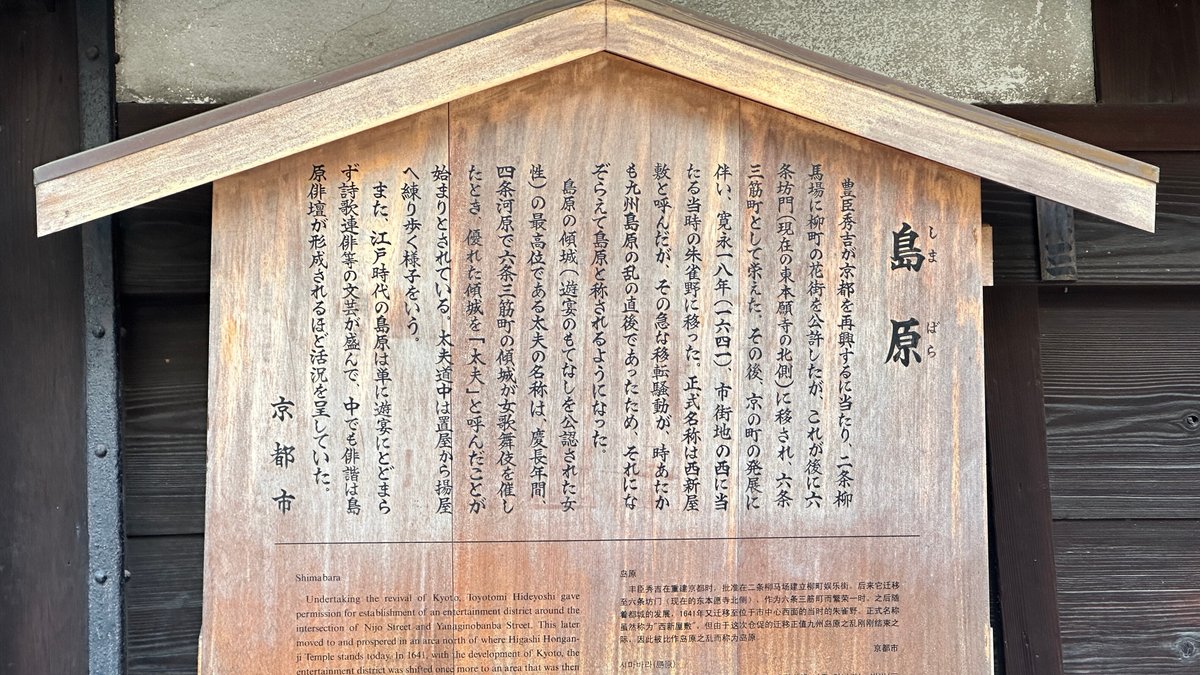
【京都時間.jp】第38回 京都に残る隠れ花街「島原」 古都の風情を感じる
京都といえば、金閣寺や清水寺、伏見稲荷など数多くの有名な名所旧跡が存在する古都です。しかし、町家が立ち並ぶ下京区の静かな住宅街一角に、かつての遊里の華やかな面影が色濃く残る風情ある空間があることをご存知でしょうか。それが島原(しまばら)という、京都で最も古い由緒を誇る花街なのです。


島原の起源は室町時代に遡ります。当時、足利義満公が現在の東洞院通七条下るあたりに、いわゆる遊所となる"傾城町"を許可したのがその始まりです。しかし桃山時代の1589年、豊臣秀吉公の許可を得て二条柳町に移転。さらに江戸時代に入ると六条付近へと移されましたが、1641年に島原の地へ移り住むことになりました。以来"島原"と呼ばれるようになったこの名の由来には、当時の島原の乱の混乱した様子に似ていたこと、あるいは当地が田畑に囲まれた"島"のようだったことから名付けられた、という二つの説があります。

移り住んだ当初から、島原は堀に囲まれた独立した区画に整備され、東の大門が設けられました。居住者は島原内の出入りは自由でしたが、外部からの立ち入りは門から通行できるだけで完全に閉ざされた世界だったと聞きます。しかし、このような閉鎖的な環境とは裏腹に、清河八郎や頼山陽らの実母が揚屋で遊んだ例もあり、一般人の自由な出入りも許されていたようです。


およそ400年の歴史の中で、花街島原は京都の文化芸術に深く根付いてきました。特に太夫と呼ばれた最高位の遊女たちの芸事が花開きました。太夫には、書画・茶道・舞踊・詩歌といった高い教養が求められ、優雅で艶やかな風情を漂わせていたそうです。彼女たちは正五位の上級官位の待遇を受け、御所の公家や皇族が主な客だったことから、気品と風格を体現していたに違いありません。

この島原で活躍した吉野太夫、桜木太夫、夕霧太夫、宗竹太夫など、数多くの名だたる名妓の名を今に伝えています。島原が最盛期を迎えたのは元禄期で、幕末には新選組隊士や西郷隆盛ら志士の姿もありました。幕末の混乱期には、島原は当時の政情に影響されたのか、華やかさを失いつつありました。

明治維新により幕府崩壊、天皇は東京へ奠都し公家や武家からの常連客が減少。島原は衰退の一途を辿ります。しかし太夫たちは島原女紅場を設けるなど、伝統の継承と文化活動を続けていました。昭和初期には芸者置屋本位の花街と変わりましたが、次第に建物が取り壊され、島原の面影はほとんど失われてしまいました。
今でも現役の太夫たちが島原の伝統を脈々と受け継ぎ、輪違屋に所属しながら舞を披露したり祭礼で太夫道中に姿を見せてくれます。振袖や時代袴の着物姿、たるみのない日本髪、そして優雅な所作と詠歌には、京の粋を体現した風格と品が漂っています。

島原を散策すれば、昔ながらの石畳の道や島原住吉神社、輪違屋をはじめとする史跡に行き当たります。時代の荒波に翻弄されながらも、かろうじて名残を留めた情緒は、旅人の心に哀しみと郷愁を呼び覚ます一方で、芸事に貫かれた卓越した美意識にも出会える場面もあります。

島原を訪れれば、歴史の重みに思いを馳せながら、京の古来の風情に感じることができます。この古都に残された、極めて小さな秘密の空間では、京都らしい品格と気品に出会える魅力があります。散策を終えたあと、風情ある町家で頂く抹茶と塗り物の器に映る景色も、またたのしいひとときとなることでしょう。訪れてほしい京の町の一つです。

When speaking of Kyoto, one recalls the ancient capital teeming with numerous famous sites such as Kinkaku-ji, Kiyomizu-dera, and Fushimi Inari. However, in a quiet residential area of Shimogyo Ward, lined with traditional townhouses, there exists a space where the glamorous remnants of the past pleasure quarters are vividly preserved. This place is Shimabara, the oldest and most prestigious geisha district in Kyoto.
The origin of Shimabara dates back to the Muromachi period. It all began when Ashikaga Yoshimitsu allowed the establishment of a pleasure district known as "Keisei Machi" around the current area south of Shichijo on Higashinotoin Street. However, in 1589, during the Momoyama period, with the permission of Toyotomi Hideyoshi, it was relocated to Nijo Yanagimachi. Entering the Edo period, it moved near Rokujo but eventually settled in the Shimabara area in 1641. The name "Shimabara" is said to have originated either from the chaotic state resembling the Shimabara Rebellion at that time or because the area was surrounded by fields, resembling an "island".
From its initial settlement, Shimabara was organized as a gated community, enclosed by a moat, with a large gate set up to the east. Residents could freely enter and exit Shimabara, but entry from outside was strictly controlled through the gate, creating a completely secluded world. Despite this closed environment, notable figures such as Kiyokawa Hachiro and Rai Sanyo's mother were known to have visited the yujo (courtesans), indicating that the area was accessible to the general public.
Throughout its approximately 400-year history, Shimabara deeply rooted itself in Kyoto's culture and arts. The highest rank of courtesans, known as tayu, flourished here with their arts. Tayu were expected to have high cultural accomplishments in calligraphy, tea ceremony, dance, and poetry, exuding elegance and grace. They were treated with the respect of a senior fifth rank official and mainly served court nobles and royalty, embodying nobility and dignity.
Shimabara is renowned for legendary courtesans such as Yoshino Tayu, Sakuragi Tayu, Yugiri Tayu, and Sotake Tayu. Its heyday was during the Genroku period, and by the end of the Edo period, figures such as members of the Shinsengumi and Saigo Takamori were seen here. During the tumultuous times of the Bakumatsu period, Shimabara's glamour began to wane, influenced by the political situation of the time.
With the Meiji Restoration leading to the fall of the shogunate and the emperor moving to Tokyo, Shimabara faced a decline as regular patrons from the aristocracy and samurai classes decreased. However, the tayu continued to uphold traditions and cultural activities, setting up Shimabara Jogakoba (Shimabara Women's School). By the early Showa period, it transformed into a geisha district dominated by geisha houses, but gradually, many buildings were demolished, and much of Shimabara's legacy was lost.
Today, active tayu still inherit Shimabara's traditions, performing dances at Wachigaiya and making appearances in tayu processions at festivals. Their attire, including long-sleeved kimono and period hakama, neatly arranged Japanese hairstyles, and elegant manners and recitations, epitomize the sophistication and grace of Kyoto.
Exploring Shimabara, one encounters cobblestone streets, Shimabara Sumiyoshi Shrine, Wachigaiya, and other historic sites. Despite being tossed by the waves of time, the remnants of its past stir feelings of sadness and nostalgia in travelers, while also presenting moments of extraordinary aesthetic sensibility through its arts.
A visit to Shimabara allows one to ponder the weight of history while experiencing the ancient ambiance of Kyoto. In this small, secret space preserved in the old capital, one can encounter the charm of Kyoto's elegance and refinement. After a stroll, enjoying matcha and viewing the scenery reflected in lacquerware at a traditional townhouse offers another delightful moment. It is one of Kyoto's towns worth visiting.
